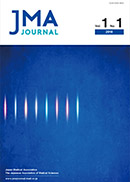6 巻, 4 号
選択された号の論文の38件中1~38を表示しています
- |<
- <
- 1
- >
- >|
Review Article
-
原稿種別: Review Article
2023 年 6 巻 4 号 p. 365-370
発行日: 2023/10/16
公開日: 2023/11/16
PDF形式でダウンロード (2270K) -
原稿種別: Review Article
2023 年 6 巻 4 号 p. 371-380
発行日: 2023/10/16
公開日: 2023/11/16
PDF形式でダウンロード (4269K) -
原稿種別: Review Article
2023 年 6 巻 4 号 p. 381-386
発行日: 2023/10/16
公開日: 2023/11/16
PDF形式でダウンロード (1837K)
Editorial
-
原稿種別: Editorial
2023 年 6 巻 4 号 p. 387
発行日: 2023/10/16
公開日: 2023/11/16
PDF形式でダウンロード (1787K)
Review Article
-
原稿種別: Review Article
2023 年 6 巻 4 号 p. 388-392
発行日: 2023/10/16
公開日: 2023/11/16
PDF形式でダウンロード (4163K)
Original Research Article
-
原稿種別: Original Research Article
2023 年 6 巻 4 号 p. 393-396
発行日: 2023/10/16
公開日: 2023/11/16
PDF形式でダウンロード (1811K) -
原稿種別: Original Research Article
2023 年 6 巻 4 号 p. 397-403
発行日: 2023/10/16
公開日: 2023/11/16
PDF形式でダウンロード (2175K) -
原稿種別: Original Research Article
2023 年 6 巻 4 号 p. 404-413
発行日: 2023/10/16
公開日: 2023/11/16
PDF形式でダウンロード (4398K)
Editorial
-
原稿種別: Editorial
2023 年 6 巻 4 号 p. 414-415
発行日: 2023/10/16
公開日: 2023/11/16
PDF形式でダウンロード (1798K)
Original Research Article
-
原稿種別: Original Research Article
2023 年 6 巻 4 号 p. 416-425
発行日: 2023/10/16
公開日: 2023/11/16
PDF形式でダウンロード (2872K) -
原稿種別: Original Research Article
2023 年 6 巻 4 号 p. 426-436
発行日: 2023/10/16
公開日: 2023/11/16
PDF形式でダウンロード (2192K) -
原稿種別: Original Research Article
2023 年 6 巻 4 号 p. 437-447
発行日: 2023/10/16
公開日: 2023/11/16
PDF形式でダウンロード (2318K) -
原稿種別: Original Research Article
2023 年 6 巻 4 号 p. 448-454
発行日: 2023/10/16
公開日: 2023/11/16
PDF形式でダウンロード (3381K) -
原稿種別: Original Research Article
2023 年 6 巻 4 号 p. 455-462
発行日: 2023/10/16
公開日: 2023/11/16
PDF形式でダウンロード (5721K) -
原稿種別: Original Research Article
2023 年 6 巻 4 号 p. 463-469
発行日: 2023/10/16
公開日: 2023/11/16
PDF形式でダウンロード (2092K) -
原稿種別: Original Research Article
2023 年 6 巻 4 号 p. 470-480
発行日: 2023/10/16
公開日: 2023/11/16
PDF形式でダウンロード (2515K) -
原稿種別: Original Research Article
2023 年 6 巻 4 号 p. 481-486
発行日: 2023/10/16
公開日: 2023/11/16
PDF形式でダウンロード (2079K)
Editorial
-
原稿種別: Editorial
2023 年 6 巻 4 号 p. 487-488
発行日: 2023/10/16
公開日: 2023/11/16
PDF形式でダウンロード (1799K)
Original Research Article
-
原稿種別: Original Research Article
2023 年 6 巻 4 号 p. 489-498
発行日: 2023/10/16
公開日: 2023/11/16
PDF形式でダウンロード (2935K) -
原稿種別: Original Research Article
2023 年 6 巻 4 号 p. 499-504
発行日: 2023/10/16
公開日: 2023/11/16
PDF形式でダウンロード (2033K)
Clinical Trial
-
原稿種別: Clinical Trial
2023 年 6 巻 4 号 p. 505-512
発行日: 2023/10/16
公開日: 2023/11/16
PDF形式でダウンロード (2220K)
Opinion
-
原稿種別: Opinion
2023 年 6 巻 4 号 p. 513-514
発行日: 2023/10/16
公開日: 2023/11/16
PDF形式でダウンロード (1800K) -
原稿種別: Opinion
2023 年 6 巻 4 号 p. 515-519
発行日: 2023/10/16
公開日: 2023/11/16
PDF形式でダウンロード (2756K) -
原稿種別: Opinion
2023 年 6 巻 4 号 p. 520-522
発行日: 2023/10/16
公開日: 2023/11/16
PDF形式でダウンロード (2967K) -
原稿種別: Opinion
2023 年 6 巻 4 号 p. 523-526
発行日: 2023/10/16
公開日: 2023/11/16
PDF形式でダウンロード (1819K) -
原稿種別: Opinion
2023 年 6 巻 4 号 p. 527-531
発行日: 2023/10/16
公開日: 2023/11/16
PDF形式でダウンロード (2160K)
Short Communication
-
原稿種別: Short Communication
2023 年 6 巻 4 号 p. 532-535
発行日: 2023/10/16
公開日: 2023/11/16
PDF形式でダウンロード (1836K) -
原稿種別: Short Communication
2023 年 6 巻 4 号 p. 536-538
発行日: 2023/10/16
公開日: 2023/11/16
PDF形式でダウンロード (1808K)
Images
-
原稿種別: Images
2023 年 6 巻 4 号 p. 539-540
発行日: 2023/10/16
公開日: 2023/11/16
PDF形式でダウンロード (2339K) -
原稿種別: Images
2023 年 6 巻 4 号 p. 541-542
発行日: 2023/10/16
公開日: 2023/11/16
PDF形式でダウンロード (5221K) -
原稿種別: Images
2023 年 6 巻 4 号 p. 543-545
発行日: 2023/10/16
公開日: 2023/11/16
PDF形式でダウンロード (3469K) -
原稿種別: Images
2023 年 6 巻 4 号 p. 546-547
発行日: 2023/10/16
公開日: 2023/11/16
PDF形式でダウンロード (2501K)
Case Report
-
原稿種別: Case Report
2023 年 6 巻 4 号 p. 548-551
発行日: 2023/10/16
公開日: 2023/11/16
PDF形式でダウンロード (3024K) -
原稿種別: Case Report
2023 年 6 巻 4 号 p. 552-555
発行日: 2023/10/16
公開日: 2023/11/16
PDF形式でダウンロード (7716K) -
原稿種別: Case Report
2023 年 6 巻 4 号 p. 556-560
発行日: 2023/10/16
公開日: 2023/11/16
PDF形式でダウンロード (9393K) -
原稿種別: Case Report
2023 年 6 巻 4 号 p. 561-564
発行日: 2023/10/16
公開日: 2023/11/16
PDF形式でダウンロード (2300K)
Editorial
-
原稿種別: Editorial
2023 年 6 巻 4 号 p. 565-566
発行日: 2023/10/16
公開日: 2023/11/16
PDF形式でダウンロード (1792K)
Letter to the Editor
-
原稿種別: Letter to the Editor
2023 年 6 巻 4 号 p. 567-568
発行日: 2023/10/16
公開日: 2023/11/16
PDF形式でダウンロード (1792K)
- |<
- <
- 1
- >
- >|
